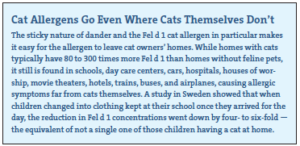Cats are thought to be the third most common cause of indoor allergies (after pollen and house dust mites). Yet few allergic cat owners are willing to part with their pets. In one online survey, 84 percent of respondents reported that they would ignore advice to give up their cat to help manage allergies.
The answer, then, is not to advise people to relinquish their cats but to help them tamp down on miserable allergy symptoms. How?
A short course on how cat allergens get into the air
Eight cat allergens are currently recognized by the World Health Organization, but one is responsible for symptoms in 60 to 90 percent of cat-allergic individuals. Called Fel d 1, it can be found both in feline saliva and in the oil-producing glands, or sebaceous glands, of a cat’s skin. It is thought that while the allergen is troublesome for people, it serves a biological function in felines, perhaps in transporting hormones, steroids, or pheromones.
Skin production of Fel d 1 varies depending on what part of a cat’s body is producing it. For instance, the facial region has higher amounts than the chest — no surprise to those whose sneezing becomes worse when their cat bumps against them with his head.
But one of the main ways cat allergens get into our environments occurs when felines self-groom. The saliva they deposit on their coats with their tongues spreads the offending substance all over their bodies, as well as distributing the allergen that is produced directly in the skin itself. It’s then shed in dander — a combination of dried saliva, flakes of skin, and bodily debris — and settles in household dust. The small size of the allergen also allows it to remain airborne for several days, easily reaching human airways.
New thinking on what not to do
One piece of advice frequently given is to make certain rooms in the home off-limits to cats, the bedroom in particular. But British veterinarian Andrew H. Sparkes, BVetMed, writing in the Journal of Feline Medicine and Surgery, says that “environmental restriction might have important welfare implications for cats, potentially resulting in chronic frustration and behavioural issues.” He also points out that closing a door won’t necessarily keep out enough dander to dampen allergic reactions; it’s not like the dander can’t get through the door frame of a closed door. You need to decide, perhaps with the help of your veterinarian, to what degree keeping your cat out of your bedroom would help your symptoms and weigh that against how it might affect your pet’s emotional comfort and your bond with him.
Frequent bathing is another recommendation often made in order to send dander down the drain rather than into the air. But studies on the efficacy of cat bathing for mitigating allergies have been inconsistent at best. It’s not that bathing doesn’t reduce allergens on cats’ coats. It’s that the allergen levels start creeping up again very quickly. Concentrations return to pre-bathing levels anywhere from 24 hours to one week later.
Since many cats hate to be bathed, that’s a lot to put a pet through for a very-short lived effect. Dr. Sparkes writes that it “would need to be carefully assessed against the potential stress this would cause for the cat and the damage to the human-cat bond.”
But if you’re not going to keep your cat out of your bedroom or bathe him very frequently, what can you do?


Steps to take
Fortunately, there are a number of ways to reduce cat allergens in your home. None of them alone will do all that much. But taken together, they could have a significant impact.
- Remove as much upholstered furniture as possible, especially from bedrooms, as concentrations of cat allergens in soft furnishings are particularly high.
- Remove carpeting from as many rooms as possible and replace
with hard flooring; carpeting is known to harbor large quantities of allergen-containing dust. - Use allergy-proof mattress and pillow covers, meaning covers with a mean pore size of less than 4 to 6 micromoles. Mattresses, like soft furnishings, carry large amounts of allergen-containing dust.
- Consider having a “cat outfit” for interacting with your cat while relaxing at home so that large amounts of cat dander do not end up on your entire wardrobe.
- Vacuum floors, carpets, and furniture at least once a week with a vacuum cleaner that incorporates a high-efficiency particulate (HEPA) filter. Such cleaners will not leak and disperse allergens.
- Add an air cleaner with a HEPA filter to central air conditioning and heating. That will help stop allergens from circulating throughout the house.
- Wash bedding and curtains regularly.
- Wipe down walls and wash hard floors regularly.
- Wash your hands immediately after petting your cat — and before touching your hands to your face.
- Keep windows open, even if just a crack. It is believed that our spending more and more time in enclosed environments has contributed to the increase in cat allergies over the years.
- Install a nighttime laminar airflow system over your bed. It may help displace allergen-saturated air from your breathing area.
- Consider getting a female cat or neutered male cat over an intact male the next time you adopt. No cat is hypoallergenic despite claims to the contrary, but
intact males produce greater amounts of Fel d 1 than females or neutered males.





My indoor/outdoor 2 yr old tabby suddenly refusing to go outdoors. Usually caught a vole or mouse every few days. Now looks out every window but nothing entices him to go back outside. He was leash trained as a kitten so I tried that. I held him and sat on bench but he ran to the door. Help
Your cat is just like my very smart rescue kitties. He knows where the safest place is. The outdoors has so many dangers for a cat–cars, dogs, feline leukemia, feline AIDS, and bites from other cats not to mention the weather. Once they were taken in, our kitties at first seemed terrified of the windows and door thinking they would be put out again. Now they watch “kitty TV”–a bird feeder and bird bath in the yard, the squirrels chasing up and down the trees, and rain or snow falling while they are safe indoors. With a wide variety of wand toys that we entertain them with plus all their other toys that they can play with alone or with each other and perches to climb, why would they want to be outside constantly keeping a watch for any danger? The day our oldest rescue who was deaf and living in a city parking lot stretched out on her side and fell asleep instead of lying in a tightly curled ball said everything to me-“Thank you, I’m safe now”.
I am sorry that the Live Clear food isn’t mentioned in this article!